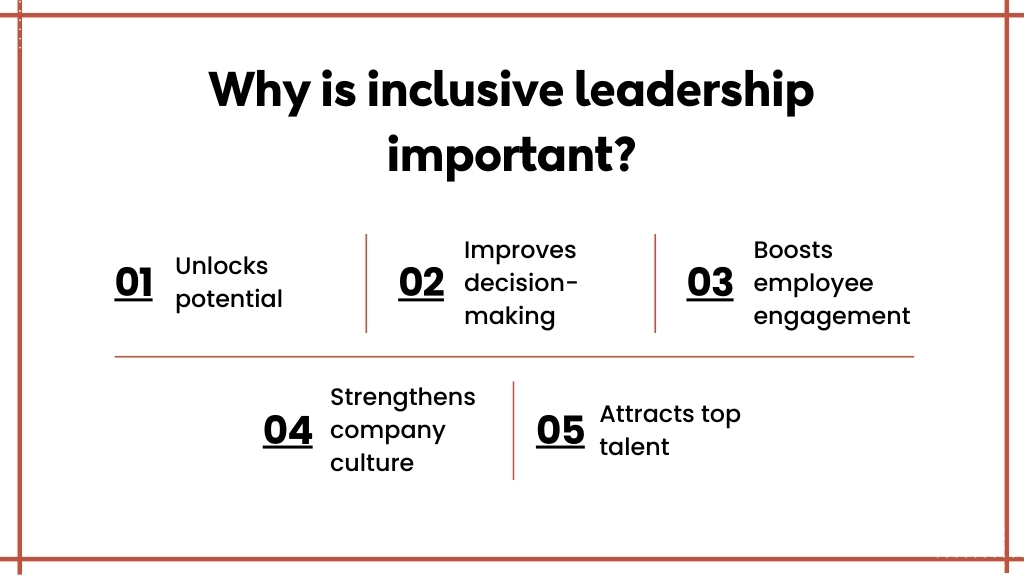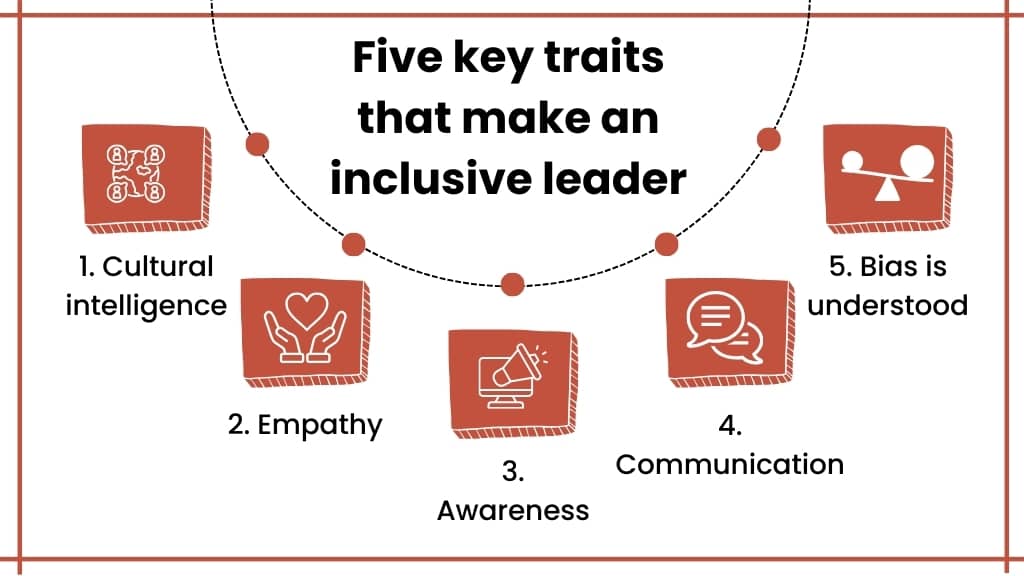Introduction
Inclusion is not just a choice. It is a necessity for any organization that wants to thrive in today’s diverse world.
According to a recent study, inclusive leaders see a 17% increase in team performance, a 20% increase in decision-making quality, and a 29% increase in team collaboration. Moreover, they cut down employee attrition risk by 76%.
However, being an inclusive leader isn’t just about ticking off a box. You need to develop a set of skills and traits over time.
In this article, we’ll explore the top five inclusive leadership skills that can help you create a thriving workplace where everyone feels valued, respected, and included. But before that, let’s understand what inclusive leadership is.
What is inclusive leadership?
Inclusive leadership is a leadership style that actively values and leverages the strengths of a diverse team. It’s not just about having a diverse team, but also creating a welcoming environment where everyone feels respected and empowered to contribute.
According to Smaiyra Million P’21, executive director of Babson’s Arthur M. Blank Center for Entrepreneurship, “Inclusive leadership means having the ability to lead a diverse group of people while demonstrating respect for each person’s unique characteristics without bias.”
Diversity brings a rich tapestry of experiences and ideas to the table. And inclusive leadership ensures all those threads get woven together into a strong, creative whole. This connection is crucial for successful diversity and inclusion (D&I) initiatives, as it allows everyone to thrive and contribute to the team.
Read more – 7 steps to lead diverse teams effectively in the workplace
Why is inclusive leadership important?
Inclusive leadership is crucial in today’s diverse workplaces. It fosters an environment where everyone feels valued, respected, and empowered to contribute their unique talents and perspectives.

Here are a few benefits of inclusive leadership:
- Unlocks potential: Inclusive leadership taps into the collective intelligence of the team by creating a space where everyone feels safe to share ideas. This diversity of thought leads to better problem-solving and innovation.
- Improves decision-making: Inclusive leaders consider different viewpoints, reducing the risk of biases and leading to more well-rounded decisions.
- Boosts employee engagement: When employees feel valued and heard, they’re more likely to be engaged and motivated. This leads to higher productivity and satisfaction.
- Strengthens company culture: Inclusive workplaces foster a sense of belonging and collaboration, leading to a more productive and positive work environment.
- Attracts top talent: Companies known for inclusive leadership attract a wider pool of qualified candidates, giving them a competitive edge.
Five key traits that make an inclusive leader
Inclusive leadership is not only the right thing to do, but it’s also good for the whole organization.
According to a study by Deloitte, companies with inclusive cultures are twice as likely to meet or exceed financial targets.
So, by developing inclusive leadership skills, you can create a thriving workplace where everyone feels valued and included.
Here are five key traits that can make you an inclusive leader, along with some tips on how to develop these skills:

1. Cultural intelligence
An inclusive leader understands and connects with employees who come from different backgrounds. You need to appreciate cultural differences and create a welcoming and safe environment.
As Maya Angelou, a renowned author and poet, once said, “We all should know that diversity makes for a rich tapestry, and we must understand that all the threads of the tapestry are equal in value no matter what their color.”
To develop cultural intelligence, you can start by learning more about different cultures. Read books, watch documentaries, and attend cultural events to gain a deeper understanding of different customs and traditions.
You can also engage with people from different backgrounds and learn from their experiences. This can be done through networking events, mentorship programs, or even just striking up a conversation with someone from a different culture.
Read more – How to create a safe space at work?
2. Empathy
Inclusive leaders have the ability to understand and feel what others are feeling. When you have empathy, you can put yourself in other people’s shoes and respond with compassion and understanding. Empathy can help you connect with your team members and understand their needs and concerns.
“Empathy is a quality of character that can change the world.” – Barack Obama
It’s true that empathy is a powerful force that can help bring people together and create positive change. When leaders are empathetic, they can build trust with their team members and create an inclusive organizational culture.
If you want to develop empathy, there are a few things you can do. Practice active listening. When you’re talking to someone, really listen to what they’re saying and try to understand their perspective.
Ask questions to clarify their thoughts and feelings. Consider volunteering or helping others. By doing so, you can develop your empathy and compassion for others.
3. Awareness
Awareness is all about being introspective and learning from others and making an effort to identify and eliminate any unconscious biases you may have. Inclusive leaders who are aware of their biases can make better decisions, collaborate more effectively, and foster a workspace of diversity and inclusion.
As Verna Myers once said, “Diversity is being invited to the party. Inclusion is being asked to dance.”
To develop awareness, you can start by reflecting on your own biases. Ask yourself questions like,
- What assumptions do I make about certain groups of people?
- When do I feel uncomfortable around people who are different from me?
You can also ask for feedback from others, especially from people who come from different backgrounds than you. Also, practice self-reflection to become more aware of your own biases and work towards eliminating them.
4. Communication
Effective communication is essential for any leader, especially for those who want to be inclusive. Inclusive leaders make sure that everyone has a chance to contribute and be heard.
So, you need to establish clear communication channels, practice active listening, and encourage feedback. This will help you build trust, respect, and understanding among your team members.
As an inclusive leader, you need to listen actively to the ideas, opinions, and concerns of your team members. This will help you understand their needs and motivations, and build a more cohesive and effective team.
Inclusive leaders also need to learn how to give feedback constructively. This means providing feedback in a way that is clear, specific, and helpful. At the same time, you should also be open to receiving feedback from others. This will help you to identify areas where you can improve and grow as a leader.
Read more – How to master the art of giving feedback (6 hacks that no one will tell you
5. Bias is understood
“Inclusive leaders are aware of their own biases and take steps to mitigate them so that they can create a more inclusive and diverse workplace.” – Dr. Rohini Anand, Strategic DEI Advisor
Biases can impact decision-making and create an unfair and exclusive workplace. Inclusive leaders are aware of their own biases and the biases of others. They understand how biases can affect decision-making and work towards creating a more fair and inclusive workplace.
To develop this skill, you can start by learning about different types of biases. There are many different types of biases, such as confirmation bias, affinity bias, and halo effect, to name a few.
Ask for feedback from others to help you identify any biases you may have. The key is to be open to learning from different perspectives. You need to keep in mind that we all have biases, but it’s how we acknowledge and address them that makes the difference.
Conclusion
To wrap up, you need to develop inclusive leadership skills to create a workplace where everyone is valued and diversity is celebrated. This means learning how to lead in a way that welcomes and respects people from different backgrounds and abilities. By doing so, you can create a productive and healthy workplace where everyone can thrive.
For more such useful information, keep reading-
- The ultimate playbook for building high-performing teams
- Organizational culture: A complete kit for cultivating greatness in 2024
- Why emotional intelligence is important for managers
FAQs
What are the five C's for inclusive leadership?
Here are five C’s you need to keep in mind – commitment, courage, cognizance, curiosity, and cultural intelligence. By embracing these qualities, you can build a more diverse and inclusive workplace.
What are the three pillars of inclusion?
The three pillars of inclusion are diversity, equity, and belonging. By promoting diversity and equality, and creating a sense of belonging, you can foster a positive and supportive workplace culture.
What are the four key elements of inclusion?
The four key elements of inclusion are respect, acceptance, appreciation, and recognition. By showing respect for everyone, accepting differences, appreciating unique perspectives, and recognizing individual contributions, you can create an inclusive environment.
What are the four stages of inclusion?
Creating an inclusive workplace requires a journey that involves four stages. These stages are exclusion, compliance, diversity, and inclusion.




























No Comments